We recently asked Maureen Ogle, author of the Ambitious Brew, a series of questions. This is the second in a series of three posts with her answers. (Part one.)
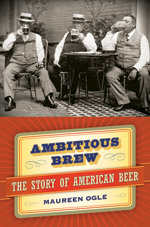 4. How is this book similar/different than the previous two? What’s next?
4. How is this book similar/different than the previous two? What’s next?
Ambitious Brew was much more ambitious (no pun intended) than my two previous books. The Key West book covers a longer period of time, but its scope is much narrower. The plumbing book, my “tenure†book, was written for an academic audience and so it had to follow a certain formula.
But with the beer book, I could let my historical creativity roam and the subject itself was so rich and so complex that the project took on a life of its own. Most of the time, the material dictated and I just tried to hang on for the ride.
Also, the book taught me a great deal about myself and about how to “do†history. I think (I hope!) I’m a much better historian now. I believe, anyway, that I rose to the challenge posed by beer, a fascinating, complex beverage with an equally fascinating, complex history.
Having said that, I should also note that my three books share certain attributes. First, I’m fascinated with the way in which American values — our “culture†— shape our material world, whether that be plumbing, cities, or food. Along the way, I’m drawn to the everyday “stuff†that we take for granted and to the lives of men and women whose drive and ambition compel them to create something from nothing.
The plumbing book, for example, examined the way in which the values of the 1840s and 1850s shaped the form and function of household water supply and waste systems. Not ideas about public health or germs, as one might expect, but a desire on the part of a newly emerging (and somewhat insecure) middle class to promote progress and individual initiative. The Key West book chronicles the way in which a handful of ambitious dreamers transformed that infertile island into a profitable venture.
Ambitious Brew examines an everyday staple by looking at the nineteenth-century German emigrés who abandoned their traditional lager and invented a new world version that appealed to the American palate. Their success transformed beer and brewing from a local and small-scale enterprise into one of the nation’s largest industries. The book also records the history of the late twentieth century visionaries who challenged corporate complacency, built “micro†breweries from scrap metal, and reinvented the industry.
I’ve already started a new book: a history of meat in America, from the great pork “factories†along the Ohio River in the 1820s, to the “organic†ranchers of the 1970s. I’m fascinated by the production and consumption of food and drink – perhaps the most revealing of all human activities – so I expect to have a grand time with this project.
5. Pick the three misconceptions you’d most like to set straight.
I think the biggest misconception is that in the 1950s, brewers dumped “adjuncts†such as corn and rice to their beer into their brewvats and did so in order to reduce production costs; to make a cheap beer to sell at a high price. Not so. Brewers began adding corn and rice to their beers in the 1860s and 1870s because non-German-Americans wouldn’t drink a heavy all-malt beer. They wanted a lighter-bodied, more effervescent beer, and the only way to make one using American barley was by adding other grains to absorb the excess proteins. Moreover, those adjunct-based beers were expensive: in the 1870s, a barrel of adjunct-based beer cost about two dollars more to make than an all-malt beer.
Another misconception is that after World War II, brewery numbers plunged as the rapacious giant Anheuser-Busch drove smaller brewers out of business. Again, not so. Between 1945 and the early 1960s, beer consumption declined or remained stagnant. Americans weren’t interested in drinking beer (they either didn’t drink at all, thanks to the prohibitionists, or they preferred hard liquor) and every brewer struggled to stay afloat.
Were the big guys more likely to survive? Sure, because they had the money to invest in things like television advertising, which was a new medium in the 1950s, and because they were able to exploit national markets more easily than were smaller brewers. But the period from 1945 to c. 1961 (when the first wave of baby boomers hit legal drinking age) was the darkest period in American brewing, and no one had an easy time of things.
Third, when I started the book, I assumed that Prohibition began in 1920. It didn’t. The Anti-Saloon League, the lobbying group that spearheaded the prohibition movement, set up shop in 1895 with a plan to drive saloons out of business. They succeeded: by 1910, half of all Americans already lived under some form of prohibition, either local or state. Brewers failed to organize a resistance movement, and were unable to fend off this piecemeal destruction. By the time the Eighteenth Amendment and the Volstead Act went into effect in January 1920, brewers had already been out of business for over a year.
Fourth (I know you only asked for three…..): Pabst Blue Ribbon labels still carry a medallion indicating that the beer was chosen as “America’s Best†at the World’s Columbian Exposition in 1893. It wasn’t! (See Chapter Three . . .)
6. Which three principals in the book (dead or alive) would you most like to have a beer with?
Oh, boy, that’s tough. Adolphus Busch and Frederick Pabst for certain. (Although I feel as though I’ve already met them: For about three months, I dreamed about them every night. We ate dinner together, walked through their breweries, took carriage rides. . . . Sounds odd, but that’s what happens to writers when we spend months on end with people, dead or alive!)
Who else? Phillip Best, the man who founded what became Pabst Brewing (Frederick Pabst married his daughter). I’d love to know if he really rolled dice to determine who got the brewery, himself or his brother.
Truth is, I’d love to meet everyone. I’ve met most of the living brewers who are featured in the book, but it would grand to sit down and talk to everyone else who landed on my pages!
Tomorrow: How did beer change for you in the course of researching and writing the book?


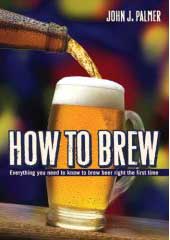
 The best known mix is a Black and Tan or Half-and-Half, and whether these are the same or different depends on where you order them. With since everybody is thinking about St. Patrick’s Day on Friday, it seems like a good time to review the basics:
The best known mix is a Black and Tan or Half-and-Half, and whether these are the same or different depends on where you order them. With since everybody is thinking about St. Patrick’s Day on Friday, it seems like a good time to review the basics: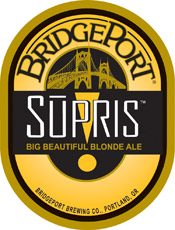 Ockert took a side trip to the Slovenian farms last year on the way to Munich to serve as a judge at the Brewing Industry International Awards. He was taken not just with the Styrian Golding hops that ended up in Sūpris, but the spirit of hop farms themselves.
Ockert took a side trip to the Slovenian farms last year on the way to Munich to serve as a judge at the Brewing Industry International Awards. He was taken not just with the Styrian Golding hops that ended up in Sūpris, but the spirit of hop farms themselves.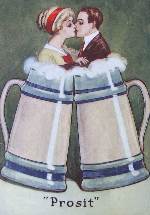 Realbeer.com certainly has seen enough promotional material to suggest otherwise. Importers such as Merchant du Vin, extolling the virtues of Lindemans lambics; craft brewers such at Boston Beer, working with a New York chef to create special recipes to go with its Chocolate Bock; and a variety of brewpubs offering special dinners … everybody is getting in the act.
Realbeer.com certainly has seen enough promotional material to suggest otherwise. Importers such as Merchant du Vin, extolling the virtues of Lindemans lambics; craft brewers such at Boston Beer, working with a New York chef to create special recipes to go with its Chocolate Bock; and a variety of brewpubs offering special dinners … everybody is getting in the act.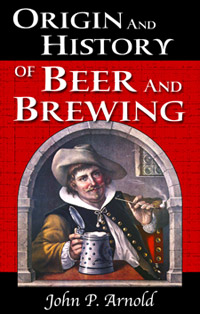
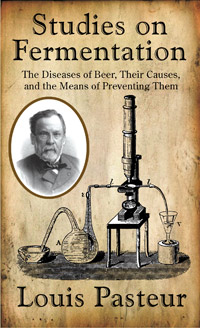
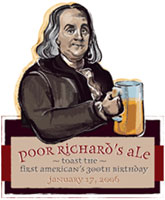 Perhaps something like Poor Richard’s Ale, the beer that officially goes on tap tomorrow to commemorate the 300th anniversary of Franklin’s birth (Jan. 17). OK, some of the 100 or so breweries across the country that brewed this special beer already have it on at others the beer isn’t quite ready to serve, but the Tuesday is the day to raise a glass to Ben.
Perhaps something like Poor Richard’s Ale, the beer that officially goes on tap tomorrow to commemorate the 300th anniversary of Franklin’s birth (Jan. 17). OK, some of the 100 or so breweries across the country that brewed this special beer already have it on at others the beer isn’t quite ready to serve, but the Tuesday is the day to raise a glass to Ben.